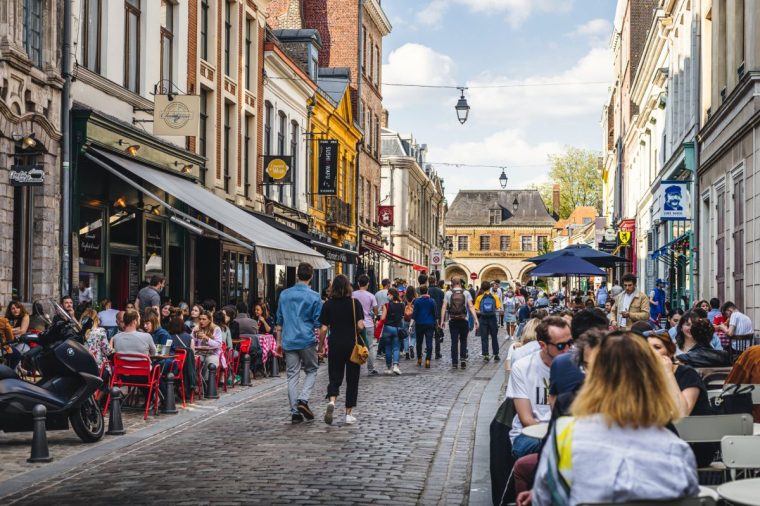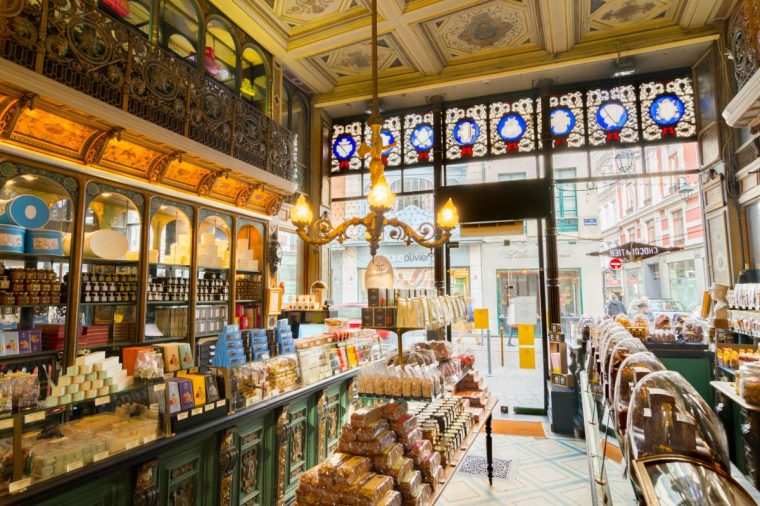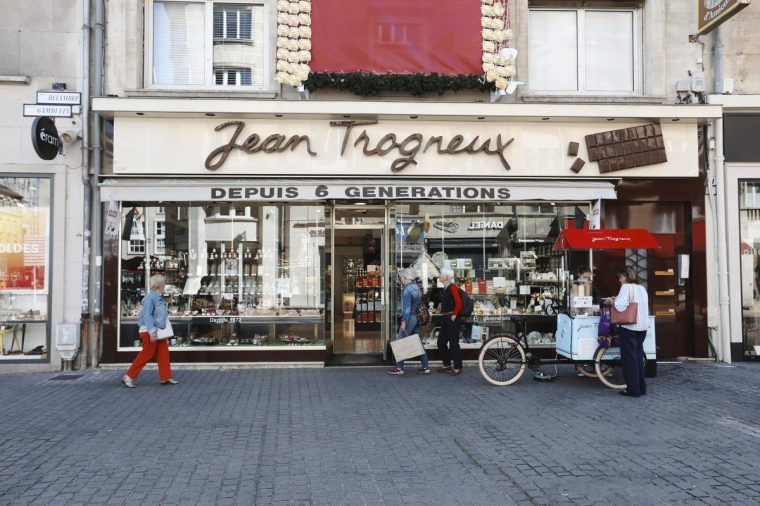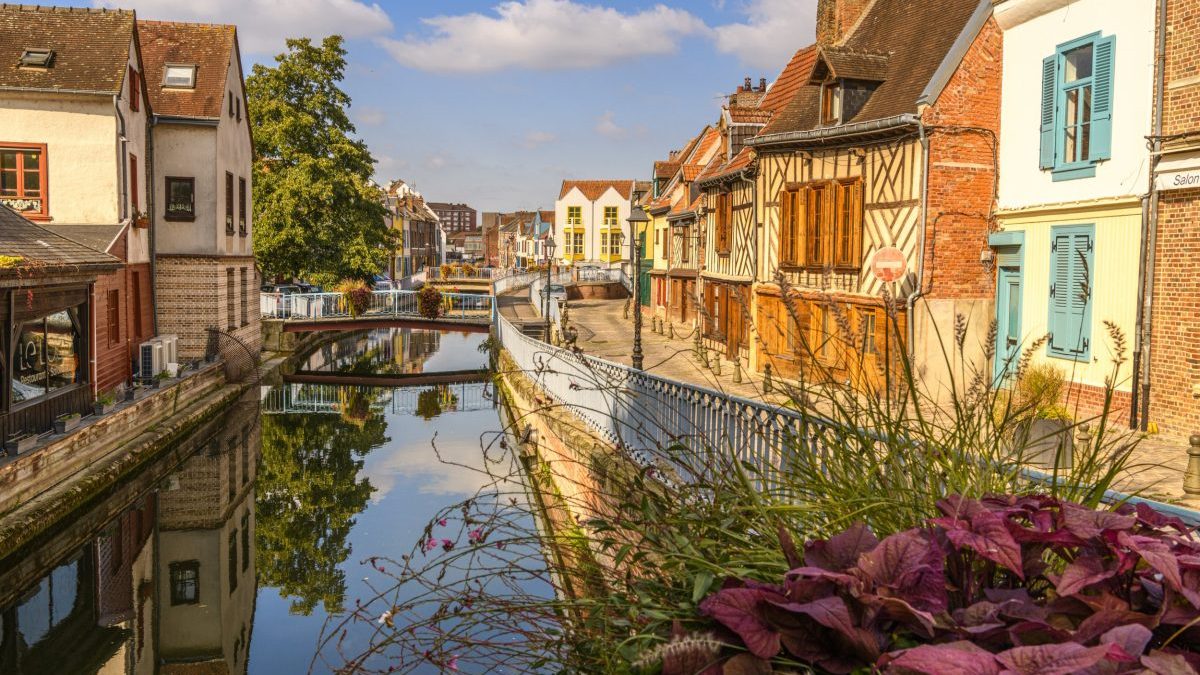With trains taking little more than an hour from London, it’s easy to zip around Hauts-de-France by rail
As I sipped a glass of chilled white, the 31°C heat simmered into dusk on the River Somme and garlic drifted from tables at Le Quai.
Lingering in Amiens’ watery Saint-Leu district, my mother and I reflected on how much can be fitted into a five-day train-hopping holiday in northern France.
Four cities, three cathedrals, a guided tour in a vintage, tangerine Citroën (with Tradi’Balade Lille), visits to an Art Deco swimming pool-turned-museum (La Piscine in Roubaix), floating gardens (The Hortillonnages, Amiens) and a First World War underground network honed by more than 500 miners (Wellington Quarry, Arras) were among the highlights. Yet we had only pruned a few short branches from the Christmas-tree shaped Hauts-de-France region.
 Lille is almost an hour quicker to reach from London than Paris (Photo: Mathieu Lassalle, lassallemathieu.com)
Lille is almost an hour quicker to reach from London than Paris (Photo: Mathieu Lassalle, lassallemathieu.com)
Our jumping-off point was Lille, a hub for Eurostar and France’s TGV (high-speed) network. High-speed track – on which trains can run up to 250kph – is the most efficient way to traverse the Continent without stepping on a plane.
Rail-curious Britons may be catching on to Lille’s quiet convenience as an alternative to changing trains in Paris. There was a 16 per cent rise in searches for Lille on Eurostar’s website in the first half of this year compared with the same period in 2024, for example.
Passing through security at London St Pancras at 7.45am, by 1pm we were sunning ourselves on the Grand Place in Lille’s old town. The train takes just one hour and 22 minutes.
The city is primed for a starring role in the Tour de France – the 22-day race sets off from Lille for the first time this year. A clock above the Chamber of Commerce was counting down to the Grand Départ this Saturday.
Opposite, on Place du Théâtre, is Chez Morel. It was one of the locations for the 2008 film Bienvenue chez les Ch’tis (“Welcome to the Sticks”), about a Provence-based public servant who is banished to the cold and inhospitable north. It holds the record for the most successful French film and was said to have boosted domestic tourism to the region. Now, it’s hard to picture Lille’s post-industrial decline in the 20th century.
A “major impetus” for decades of regeneration was the connection to the TGV Nord line in 1993 and Eurostar in 1994, a study by the University of Oxford found.
“Now it is only the wealthy and students who can live in the centre,” said Emilien, our guide from L’Échappée Bière (the beer escape), who introduced us to Lille’s brewing history and pointed us to our afternoon snack appointment at Chez Méert, founded in 1761.
 Méert’s chocolate shop has an ornate interior (Photo: Xavier Renoux)
Méert’s chocolate shop has an ornate interior (Photo: Xavier Renoux)
Here, we ate thin waffles with a vanilla filling (once a favourite of former president and Lille’s best-known son, Charles de Gaulle). There’s a restaurant and a tea room that date to the early 20th century. Details include faded maps, chandeliers, a cobbled courtyard and, in its chocolate shop, a gilded ceiling beneath which a collection of busts looks down on customers.
Two train hops along from Lille – just over an hour – is another regional institution: Amiens-founded chocolatier Jean Trogneux. There, I met Jean-Baptiste Trogneux, the great-nephew of France’s First Lady Brigitte Macron. He is the sixth generation of men in his family to run the business, which dates to 1872. He showed me Jules Verne-themed treats (the author lived in Amiens for 34 years) and gave me macarons d’Amiens to try. Wrapped in gold foil, the cakes of almond, honey and egg white are less saccharine than Paris’s pastel-hued, meringue-based versions.
 The HQ shop is one of two in Amiens
The HQ shop is one of two in Amiens
Trogneux said he hoped his daughter might one day show interest in becoming the company’s first female proprietor.
Centuries-strong tradition characterises French cuisine, but we felt on trend at seafood restaurant Krevette (Shrimp) in Lille, where diners perched on high stools at metal, communal dining tables. Our neighbours were two fiftysomething women. They helped us pick (and taste) our dishes, translating the menu when our French fell short.
Becoming more familiar with northern France felt all the smoother for the kindness of strangers and on-time, spacious, air-conditioned trains that whizzed us across verdant countryside. But it was the history that had us hooked.
 Arras’s pedestrianised Place des Héros (Photo: Frederik Astier)
Arras’s pedestrianised Place des Héros (Photo: Frederik Astier)
On Place des Héros in Arras, I learnt from my guide, Pascal, that the dozens of gabled facades that surround the city’s squares were reconstructed after the First World War according to 17th and 18th century plans. In Amiens, our guide Nathalie’s enthusiasm for the cathedral, which was spared from German bombs, was infectious. And at Arras’s Wellington Tunnels, there was moving narration of soldiers’ letters home before the ultimately failed assault on the German front.
Social history was most picturesque around La Piscine, in the city of Roubaix (25 minutes on the Metro from Lille). The grand swimming pool, now an art museum, was opened in 1932 as a public health measure.
Sun streamed in from half-moon, stained glass windows and I pictured when factory workers congregated beneath its curvedceiling to bathe and chat.
Each train stop was a reminder of just how much there is to see across the Channel, and the trip is quicker than one from London to Norwich.
Getting there
The writer travelled with Hauts-de-France Tourism.
Eurostar provided a return trip to Lille. One-way tickets start from £39, with journey times from 1 hour, 22 minutes from St Pancras to Lille Europe, eurostar.com
Regional trains start from €8 one way.
Staying there
Premier Inn London St Pancras has twin rooms from £176 per night, premierinn.com
Arbre voyageur in Lille has doubles or twin rooms from €101 (£86) per night, hotelarbrevoyageur.com/fr
Mercure Arras Centre Gare has rooms from €102, all.accor.com
Mercure Amiens Cathedrale has rooms from €119, all.accor.com
More information
